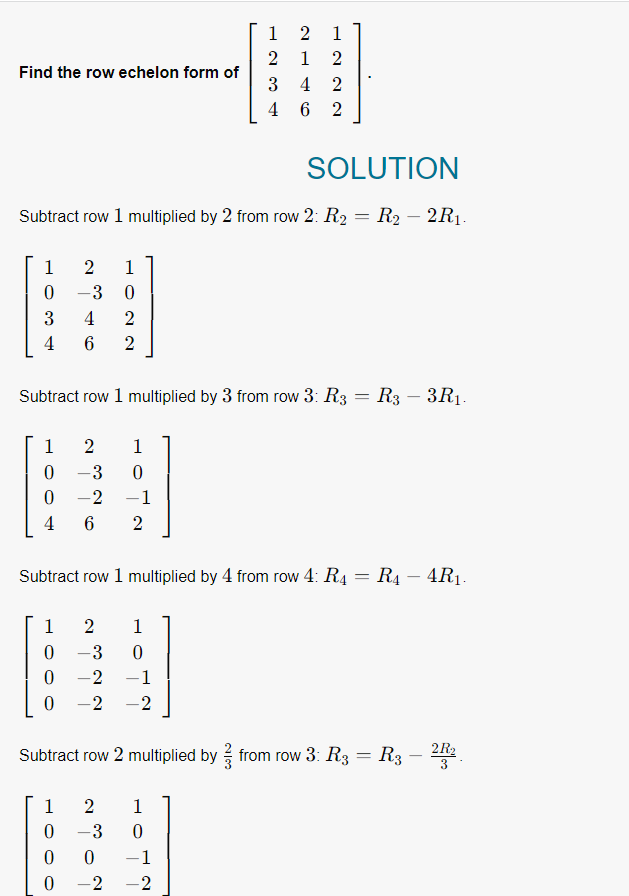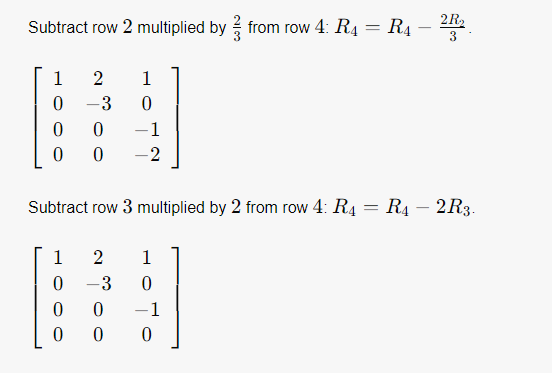6. Find a basis for each of the four subspaces associated with the matrix: [1 2 3 4] 1 4 6 2 2 2 A = 2 1
6. Find a basis for each of the four subspaces associated with the matrix: [1 2 3 4] 1 4 6 2 2 2 A = 2 1
Advanced Engineering Mathematics
10th Edition
ISBN:9780470458365
Author:Erwin Kreyszig
Publisher:Erwin Kreyszig
Chapter2: Second-order Linear Odes
Section: Chapter Questions
Problem 1RQ
Related questions
Question
![**Problem Statement:**
6. Find a basis for each of the four subspaces associated with the matrix:
\[
A = \begin{bmatrix}
1 & 2 & 3 & 4 \\
2 & 1 & 4 & 6 \\
1 & 2 & 2 & 2
\end{bmatrix}
\]
**Explanation:**
You need to find a basis for the following four fundamental subspaces related to the matrix \( A \):
1. **Column Space (C(A))**: The set of all linear combinations of the columns of \( A \).
2. **Row Space (C(A\(^T\)))**: The set of all linear combinations of the rows of \( A \), which is the same as the column space of the transpose of \( A \).
3. **Null Space (N(A))**: The set of solutions to the homogeneous equation \( A\mathbf{x} = \mathbf{0} \).
4. **Left Null Space (N(A\(^T\)))**: The null space of the transpose of \( A \), associated with the equation \( A^T\mathbf{y} = \mathbf{0} \).
To find these bases, use techniques like row reduction to echelon form, solving systems of linear equations, and employing the Gram-Schmidt process if necessary.](/v2/_next/image?url=https%3A%2F%2Fcontent.bartleby.com%2Fqna-images%2Fquestion%2Ff6c1c23e-1f73-4b65-bca5-bb8e7ffd22c6%2F82ed5a36-ac36-4237-9e55-6a3c2381ce2d%2Fgwm11u_processed.png&w=3840&q=75)
Transcribed Image Text:**Problem Statement:**
6. Find a basis for each of the four subspaces associated with the matrix:
\[
A = \begin{bmatrix}
1 & 2 & 3 & 4 \\
2 & 1 & 4 & 6 \\
1 & 2 & 2 & 2
\end{bmatrix}
\]
**Explanation:**
You need to find a basis for the following four fundamental subspaces related to the matrix \( A \):
1. **Column Space (C(A))**: The set of all linear combinations of the columns of \( A \).
2. **Row Space (C(A\(^T\)))**: The set of all linear combinations of the rows of \( A \), which is the same as the column space of the transpose of \( A \).
3. **Null Space (N(A))**: The set of solutions to the homogeneous equation \( A\mathbf{x} = \mathbf{0} \).
4. **Left Null Space (N(A\(^T\)))**: The null space of the transpose of \( A \), associated with the equation \( A^T\mathbf{y} = \mathbf{0} \).
To find these bases, use techniques like row reduction to echelon form, solving systems of linear equations, and employing the Gram-Schmidt process if necessary.
Expert Solution
Step 1
Step by step
Solved in 2 steps with 6 images

Recommended textbooks for you

Advanced Engineering Mathematics
Advanced Math
ISBN:
9780470458365
Author:
Erwin Kreyszig
Publisher:
Wiley, John & Sons, Incorporated

Numerical Methods for Engineers
Advanced Math
ISBN:
9780073397924
Author:
Steven C. Chapra Dr., Raymond P. Canale
Publisher:
McGraw-Hill Education

Introductory Mathematics for Engineering Applicat…
Advanced Math
ISBN:
9781118141809
Author:
Nathan Klingbeil
Publisher:
WILEY

Advanced Engineering Mathematics
Advanced Math
ISBN:
9780470458365
Author:
Erwin Kreyszig
Publisher:
Wiley, John & Sons, Incorporated

Numerical Methods for Engineers
Advanced Math
ISBN:
9780073397924
Author:
Steven C. Chapra Dr., Raymond P. Canale
Publisher:
McGraw-Hill Education

Introductory Mathematics for Engineering Applicat…
Advanced Math
ISBN:
9781118141809
Author:
Nathan Klingbeil
Publisher:
WILEY

Mathematics For Machine Technology
Advanced Math
ISBN:
9781337798310
Author:
Peterson, John.
Publisher:
Cengage Learning,




